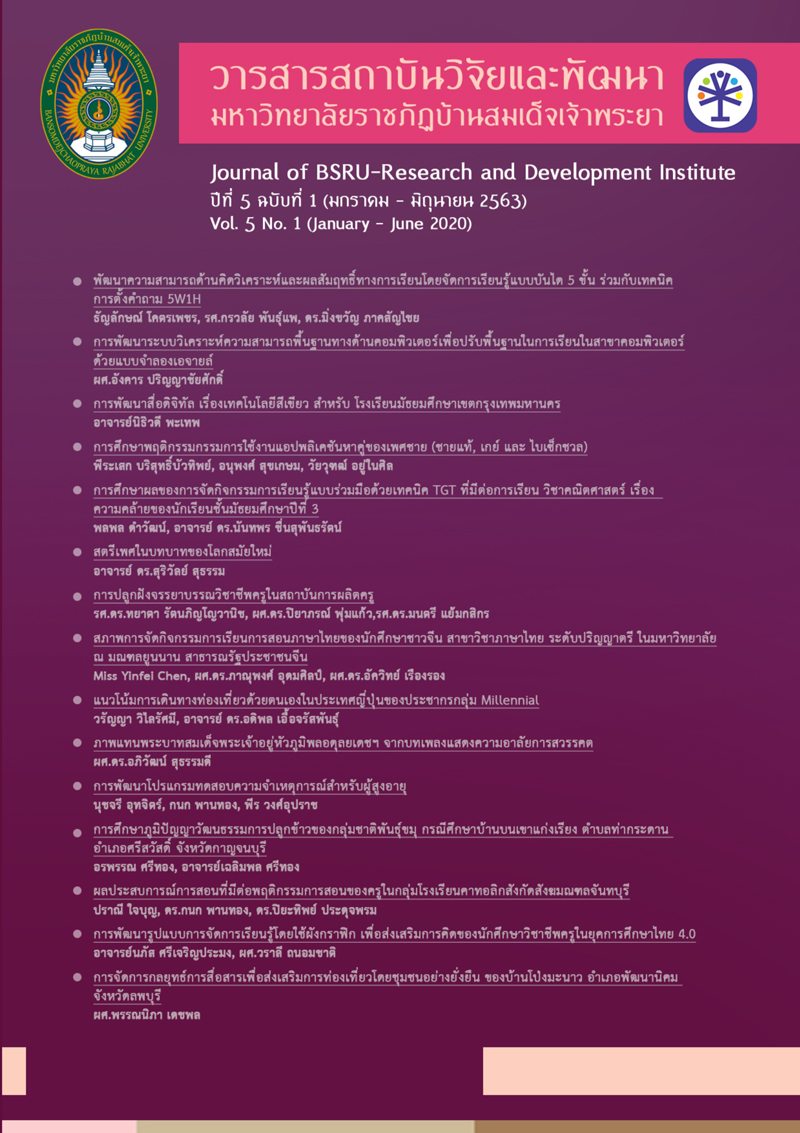EFFECTS OF TEACHING EXPERIENCES ON TEACHER INSTRUCTIONAL BEHAVIORS IN EDUCATION SECTION OF CHANTHABURI DIOCESE
Keywords:
Teacher Instructional Behaviors/ Teaching ExperiencesAbstract
The research purposes were to compare teacher instructional behaviors by classification the teaching experience. The sample groups were 157 teachers by using proportional stratified random sampling and 1,570 students by using simple random sampling. Research variables consisted of independent variable : teaching experiences that divided into 6 groups as follows: 1) less than 4 years 2) 4-7 years 3) 8-15 years 4) 16-23 years 5) 24-30 years and 6) 30 years up.
Dependent variable: teacher instructional behaviors divided into 3 aspects as follows: 1) cognitive activation, 2) classroom management, and 3) teacher-student relationship. Research instrument was the questionnaire that classified for 2 sets: 1) teachers’ questionnaires about teaching experiences, and 2) students’ questionnaires about teacher instructional behaviors. Data was analyzed by One-Way MANOVA analysis.
The research finding was Teachers with different teaching experiences had not differed in teacher instructional behaviors
Downloads
References
Apichart Pattaratuma, A. (2011). Khamu. Journal of Forest Management 5(9): 73-78
Department of Social Development and Welfare. (2012). Khmu hill tribe. Bangkok: Ministry of Social Development and Human Security.
Department of Social Development and Welfare. (2012). The cycle of Khmu people. Bangkok: Ministry of Social Development and Human Security.
General condition information. (2019). Retrieved October 22, 2019, from: http://thakadan.go.th/
public/texteditor/data/index/menu/ 498.
Hilltribe Development and Welfare Center in Mae Hong Son Province. (2002). KHAMU. Mae Hong Son.
Kongthavthong, M. (1995). Kanchanaburi Study Thai people of Karen descent in Kanchanaburi. Kanchanaburi: Art and Culture Center Kanchanaburi Rajabhat Institute.
Laphwạthn, S. (2003). Mon people on the Central Basin. Bangkok: Wạn chna.
Liamtrakoolpanich, A. (2007). Ethnobotany: Edible Plants for Khamu Amphoe Srisawat, Changwat Kanchanaburi. Office of Conservation Area 3 (Ban Pong) National Park Department Wildlife and plant species.
Loaunca, P., Panitkul, B. (2017). Rice Culture: Inheritance of Local Wisdom in Beliefs and Ritesof Southern Isan Communities. Journal of MCU Peace Studies Special Issue (292-303).
Prakob Meekotkong, P. (2015). Rice Culture Changing of Farmers in Northeast of Thailand. Research Project Funded by Mahachulalongkornrajavidyalaya University.
Premsrirat, S. (1990). Prevention and treatment of primary disease, Khmu people and public health conversation Thai - Khmu medicine. Bangkok: Institute for Language and Culture for Rural Development. Mahidol University.
Premsrirat, S. (1998). Encyclopedia of Khmu ethnic groups. Bangkok: sahadhammika.
Premsrirat, S. (2004, January - June). The diversity in language and ethnicity: an unsolved problem or a valuable resource. Journal of Language and Culture, Year 23, Issue 1.
Premsrirat, S. (2020). Ethnolinguistic Maps of Thailand. Bangkok: Office of the National Culture Commission.
Sapphasuk, W. (2016). "Kayan, Suesad, Aodton" Khmer Identity Contention for Creating Social Space of Khmer Students in Thailand - Laos Border School. Doctor of Philosophy Thesis Department of Education Major in Multicultural Education. Chiang Mai University.
Siriphan, N. (2011). Color terms and attitude toward color of Thai, Pwo Karen, Mon and Khmu in amphoe Si Sawat Kanchanaburi province. Color terms and attitude toward color of Thai, Pwo Karen, Mon and Khmu in amphoe Si Sawat Kanchanaburi province.
Subsamg, N. (1996). Khmu society and culture and development. Chiang Mai: Tribal Research Institute.
Subsamg, N. (1996). The migration of Khmu hill tribe workers Situation and impact on the community. Chiang Mai: Tribal Research Institute.
Sujachaya, S. (2001). Rice in Thai folklore – Thai. Document number 1 of the Thai Rice Foundation.
Sutthinon, S. (2018). Rice Culture: The Production and Consumption Process According to Buddhism.Doctor of Philosophy Program in Buddhist Studies Graduate School Mahachulalongkornrajavidyalaya University.
Downloads
Published
Issue
Section
License
บทความ ข้อความ ภาพประกอบ และตารางประกอบที่ลงพิมพ์ในวารสารเป็นความคิดเห็นส่วนตัวของผู้นิพนธ์ กองบรรณาธิการไม่จำเป็นต้องเห็นตามเสมอไป และไม่มีส่วนรับผิดชอบใดๆ ถือเป็นความรับผิดชอบของผู้นิพนธ์เพียงผู้เดียว






